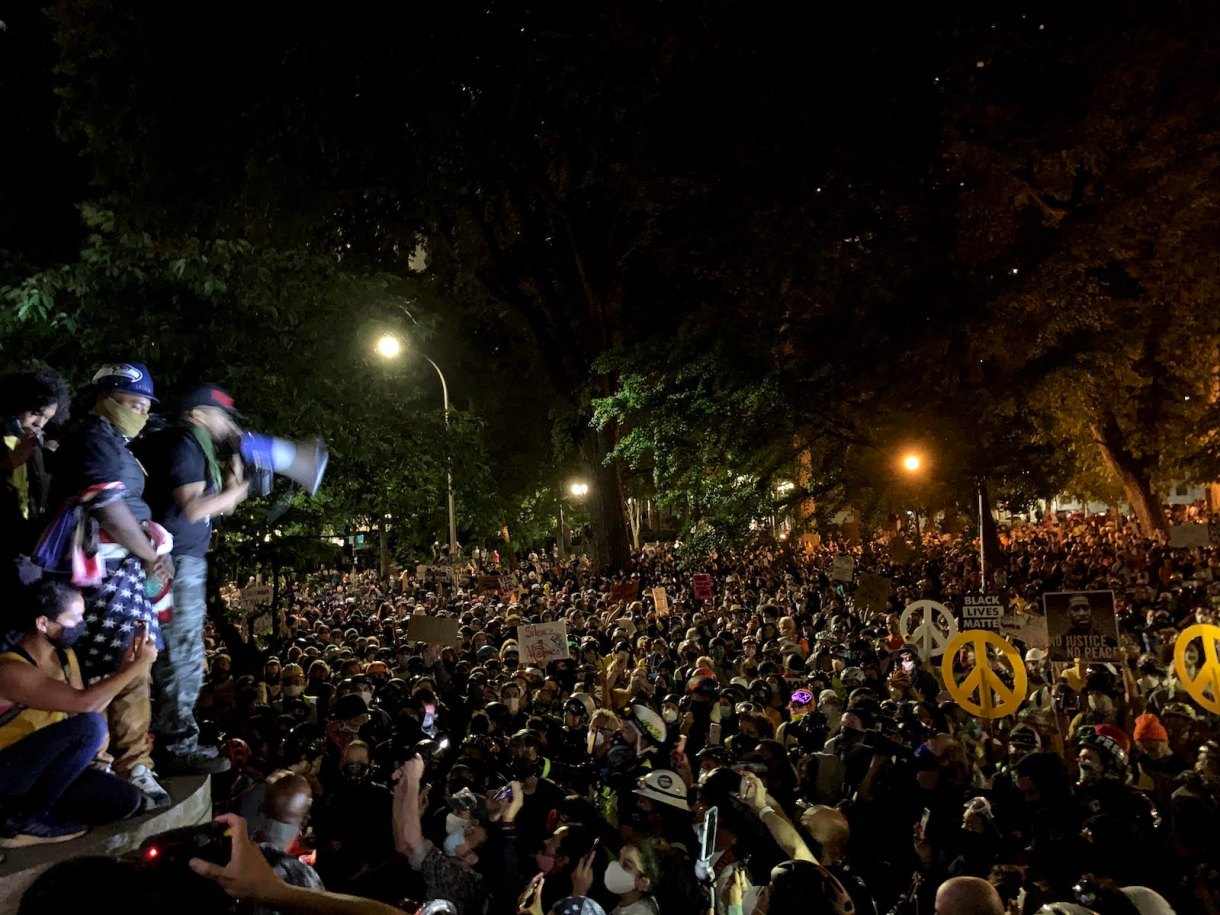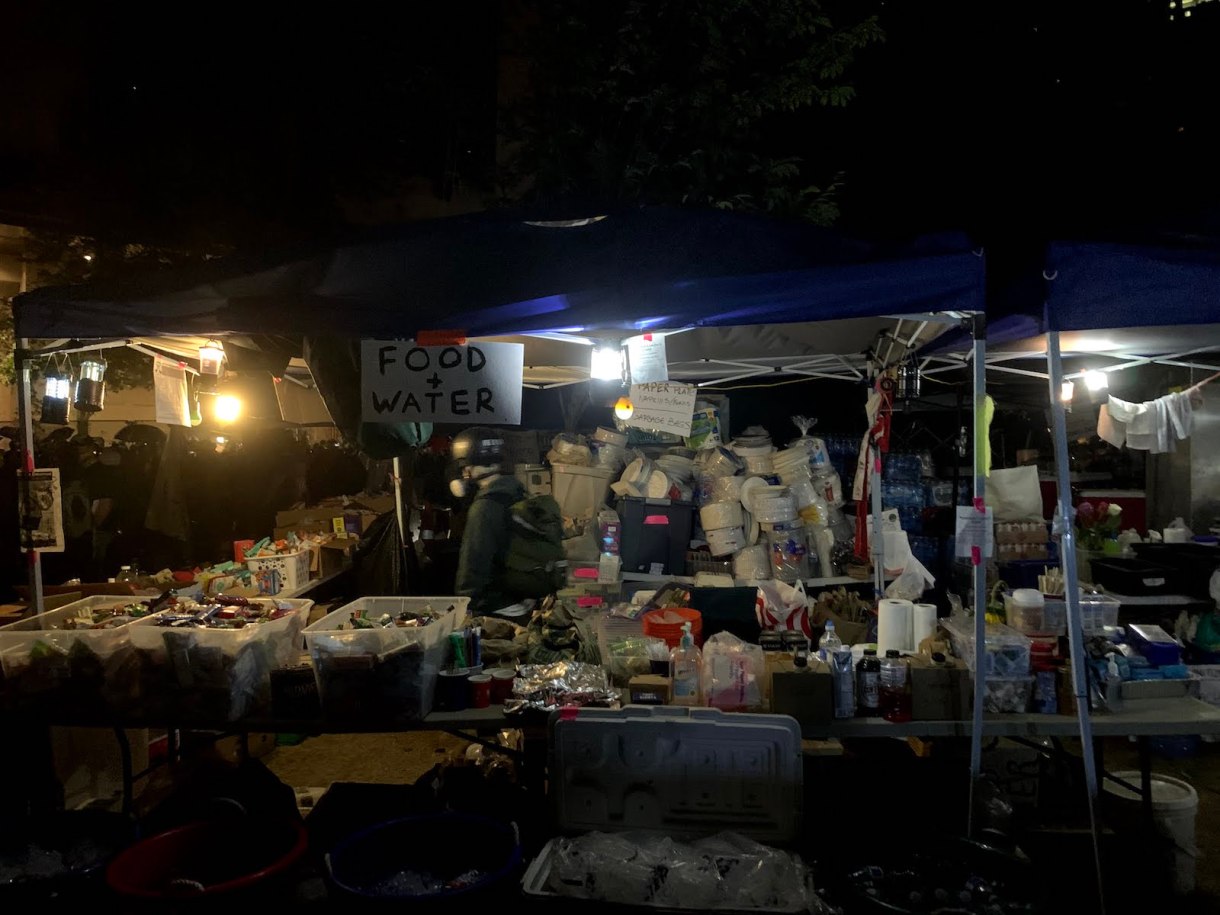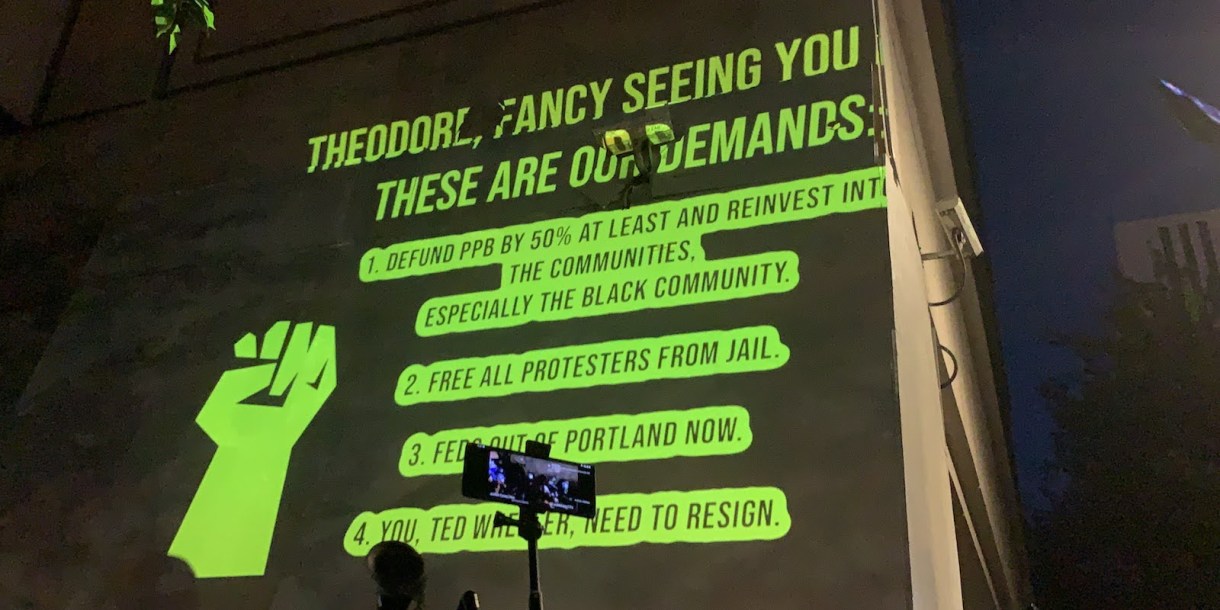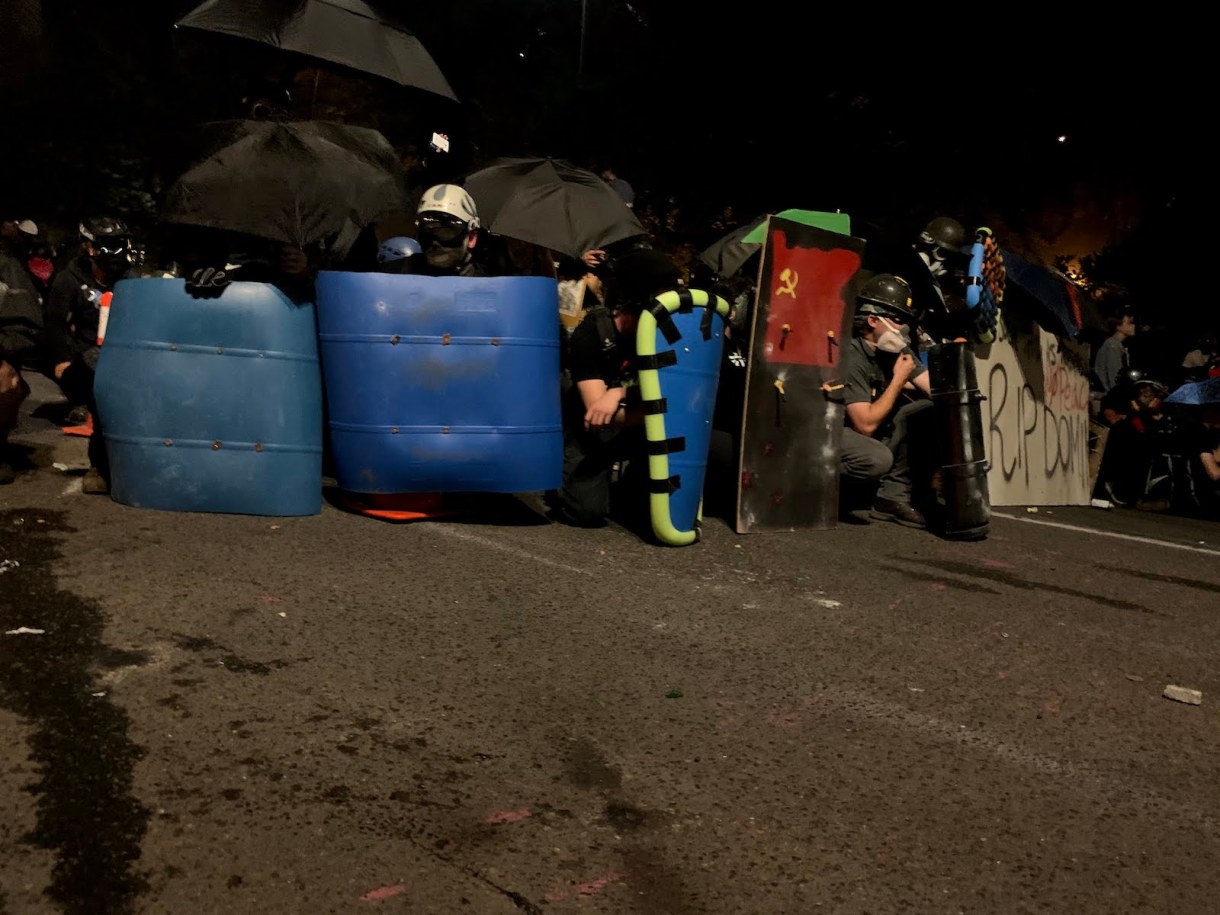Over the last few months, Donald Trump has repeatedly described Portland’s Black Lives Matter protesters as “sick and deranged anarchists and agitators.” Acting Department of Homeland Security Secretary Chad Wolf has decried the protesters as a “violent mob” of “lawless anarchists [that] destroy and desecrate property… and attack the brave law enforcement officers.” And Portland’s own mayor, Democrat Ted Wheeler, has denounced the protesters, accusing them of “attempting to commit murder” when they started a small fire outside of a police precinct.
It probably isn’t surprising that the protesters, many of whom have gathered in Portland streets for the majority of the last 110 nights — and have stopped only momentarily while air conditions are hazardous due to wildfires — describe themselves very differently than politicians and pundits do. But what may be surprising to outsiders is how tenderly the so-called “lawless anarchists” speak of each other.

Activist and We Out Here founder Mac Smiff addresses thousands of protesters outside of the Portland Police Bureau headquarters. Photo by Tuck Woodstock, July 22.
“It’s the most welcoming and caring community I’ve ever seen or been a part of,” says Jasmine, a frequent protest attendee. (We’re using a pseudonym for Jasmine to protect her identity.) “I truly believe that you could walk up to a Portland protest naked, hungry, and alone and leave with clothes, food, and comrades.”
Jasmine speaks from experience. Earlier this summer, as she walked to a protest, “literally the first two people I saw who were also in black bloc noticed I was alone and asked if I needed a group,” she says. “That night I got [free] food, medical care, supplies, and protest advice, all from complete strangers.” Weeks later, Jasmine still attends protests with the people she met that night.
Other protest attendees also speak highly of the free supplies provided both by individuals — several people have stories of strangers gifting them respirators shortly before tear gas rolled in — and by an array of self-organized affinity groups: The Witches, whose slogan is “we hex fascists,” often appear on the riot lines toting glowing wagons of water bottles, snacks, masks, and earplugs. PDX Shieldsmiths turn 55-gallon plastic barrels into DIY shields to protect against batons and crowd-control munitions. Portland Action Medics equip trained street medics with housemade eye wash, hand sanitizer, and chemical weapon wipes, used to treat the effects of tear gas and pepper spray. And, for a few glorious weeks, volunteer-run outdoor kitchen Riot Ribs served copious amounts of free food to protesters and passerby alike.

A mountain of donated food, water, and other supplies at Riot Ribs, a free, volunteer-run outdoor kitchen that fed protesters and community members throughout July. Photo by Tuck Woodstock, July 24.
These efforts (most of which, for what it’s worth, are organized by queer and trans people) are all real-life examples of mutual aid, a term coined by anarcho-communists in 1902 and re-popularized during the COVID-19 pandemic. Mutual aid occurs when people work together to take care of each other as a community; it’s a simple concept that contrasts sharply with capitalism, rugged individualism, and other systems that most Americans are raised to idolize.
“As an anarchist, this is the kind of shit I live for,” says Rosie G. Riddle, an independent journalist covering the protests. “Total strangers bandaging wounded comrades [and] offering food, water, protective equipment. Dearresting folks; shielding downed people (again, strangers) with their literal actual bodies. Offering shields for free. Posting each others’ Cash Apps to get them taken care of. The community surrounding these protests is the reason I bother getting out of bed anymore.”
Portlanders unable to take to the streets have also created roles from themselves within the movement. Sarah, a grad student at Portland State University, quickly realized that they weren’t well-suited for marching on the front lines. Instead, they cofounded AccessiBloc, a coalition of volunteers who work with independent reporters to make their protest coverage accessible to a wider audience.
“It’s something that is close to my heart because I’m hard of hearing and have low vision myself,” explains Sarah, who also does accessibility work at their day job. “A group of us get in the [Twitter] feeds of journalists and add image descriptions and captioning so they can focus while on the ground doing the documenting.”
Through AccessiBloc, Sarah enjoys the same sense of camaraderie that other protesters experience on the front lines. Once, when Sarah injured themself, a fellow AccessiBloc member immediately volunteered to drive them across town to the doctor. And when Sarah worried about covering their medical bill, protest supporters on Twitter quickly mobilized to help.
“I was panicking because I’m a student and don’t have a huge income,” says Sarah. “While I was at the doctor, I tweeted out my situation. By the time I left an hour later, my bill was completely taken care of.”
Portland’s Black Lives Matter protests have been held daily since May 29 to seek justice for Black individuals killed by police. In addition to protesting for George Floyd and Breonna Taylor, organizers — most of whom are Black, and many of whom are queer — have drawn renewed attention to instances of law enforcement killing Black Portlanders such as Patrick Kimmons and Quanice Hayes. In August, the increased pressure spurred Portland State University to disarm its campus security officers, two of whom shot and killed Jason Washington in 2018.
For most of the country, however, the Portland BLM protests only became noteworthy when news broke in mid-July that federal agents were using unmarked vans to grab protesters off the street. After national news outlets reported on US Marshals and Department of Homeland Security officers indiscriminately teargassing thousands of protesters night after night (and leaving protesters and press with lasting head injuries from crowd-control munitions), the federal forces promised to retreat from the front lines of the demonstrations, and national attention quickly faded once again.
Many Portlanders also seemed to think that the protests would end once the feds retreated in early August. But despite national reporters leaving and crowd numbers shrinking, hundreds of determined protesters continued to gather nightly to decry police brutality against Black Portlanders. At this point, the demonstrators’ demands had become more specific: defund the Portland Police Bureau by at least 20% (although many protesters insisted on 50-100%); redistribute those funds to Portland’s Black communities; drop all legal charges against protesters; and remove Mayor Ted Wheeler from office.
Instead of gathering in downtown Portland, as they had since May, protesters began planning actions at other targets across the city, bringing chants of “Black trans lives matter” and “no cops, no prisons, total abolition” to the Portland Police Association union building, the local ICE facility, and the north and east police precincts. An average evening now includes dozens or hundreds of protesters (mostly young people in black bloc) marching and chanting — and often spray-painting, throwing eggs, or setting dumpster fires. A team of journalists and ACLU and NLG legal observers tag along to document the night’s events.

Protesters project a list of demands onto the wall of the Portland Police Bureau’s downtown headquarters as Mayor Ted Wheeler attempts to dialog with members of the crowd. Photo by Tuck Woodstock, July 22.
Unsurprisingly, the Portland police bureau invariably declares these gatherings to be unlawful assemblies or riots. Using a variety of tactics — pepper balls, tear gas, foam-tipped bullets, flash bangs, batons, and violent tackles, among others —the officers typically arrest up to 25% of the crowd (sometimes including journalists, medics or legal observers) and chase the rest into dark residential neighborhoods. As law enforcement tries to disperse the crowd, protesters work together to protect each other in various ways, from creating a wall of shields to using leaf blowers to disperse tear gas.
“I was shot in the ribs with a less-lethal ammunition,” says Maddy, a protester. “The response was immediate — someone with a shield ran in front of me, my friends helped me walk away and then escape the ensuing bullrush, and medics arrived to help as soon as we could stop running.”
Countless protesters have stories of strangers offering eye flushes (useful for recovering from tear gas) and other medical care in times of crisis. They also share instances of being physically pulled to safety as police ran towards the crowd.
“The officers ran out and pushed us up against a wall, telling us to move,” says Maddy, recalling another recent incident. “Protesters began climbing the wall, simply because there was nowhere else to go. I heard someone behind me say ‘I’m getting you out of here,’ and a complete stranger lifted me by my waist like a sack of potatoes, over the fence, and in the clear.”
“I had no idea who it was or where they went, but I will forever remember it,” she says. “The fact that someone looked down and saw this tiny five-foot protester in black bloc and thought to physically lift her to safety.”
After more than three months of continuous collaboration — first providing mutual aid at the protests and later, as wildfires ravage Oregon, caring for evacuees and other vulnerable community members — Portland’s community of left-wing protesters still rarely know each other’s names. For personal safety, protest attendees often refer to each other by twitter handles or nicknames like “Beans,” “Bulba,” “Antifa Hot Dog,” and “Revolution Daddy.” Nevertheless, they’ve become closely bonded by common goals, mutual aid… and shared trauma.
Many protest attendees report feeling permanently changed by their experiences, and not always positively. “We’re all going to need therapy after this” is a popular half-joke among protesters, often uttered while listing new symptoms of post-traumatic stress. And yet, those same protesters often feel reluctant to take a day off from the front lines.
“One of the reasons being away from the protests is so difficult is because you’re forced to face a lot of the trauma and PTSD symptoms that you don’t necessarily feel when you’re on the ground,” independent journalist Alissa Azar wrote in a recent tweet. “Jumping and flinching at sudden sounds; turning your head when someone gasps because you’re worrying riot cops are about to storm in from behind you and brutalize people, even though you’re nowhere near any kind of action… [that’s] not something everyone can understand.”

Protesters work together to create a protective shield line, holding their ground as federal officers fire pepper balls in their direction. Photo by Tuck Woodstock, July 21.
It’s not surprising, therefore, that many protest attendees now struggle to connect with friends and family who haven’t spent time on the front lines and don’t engage with the protests online. After all, the vast majority of Portlanders have continued to move through their lives as if the protests aren’t happening — a choice that can make traumatized protesters feel alienated, angry, or abandoned. “There’s this rift, or a feeling that they aren’t being understood, or a new impatience with people — like ‘how can you still act the same when all this has happened?’” explains Cata Gaitán, an independent journalist in Portland.
While Cata emphasizes that they’re not a scientist, they nevertheless have a theory about what’s been taking place: “I think protesters experience this constant loop of adrenaline/cortisol/serotonin from being angry, scared, and then momentarily relieved,” Cata says. “They are upset with cops; then they get chased, beaten, gassed, and shot at by cops; then they successfully escape those cops; then it all repeats itself moments later. And the people you experience that with become like a family, because you’ve gone through so much trauma together.”
“Family” is not a word that most people would use to describe a group of anonymous antifascist protesters. But after more than 100 days of protesters chanting “stay together, stay tight” and “we keep each other safe,” of them giving eye washes and safe rides to strangers, of them handing out free pizza and masks and hand sanitizer to anyone who asks, of them dearresting each other and bailing each other out of jail, it’s the only word that seems to fit.
Even Cata, the reporter, has a story of feeling like part of the family. As it turns out, they were trapped in the same rush as Maddy, where protesters began climbing a wall to avoid being kettled by police. As the officers drew closer, an anonymous protester reached out a hand to Cata. They wrapped their arms around the stranger’s neck and were lifted up and over the wall.
“That was the first ‘hug’ I’ve gotten in months,” says Cata. “I don’t think I’ve ever had a moment where I felt so protected and cared for — and it was by a complete stranger.”
“For three slow-motion seconds, I felt safe.”



I’ve appreciated your updates from over here on the east coast the last few months. Also, I was NOT paying attention to the byline and I still knew it was your writing!
I would like to get on your email list and get or buy a Black Lives Matter sign to promote my feelings about justice and institutional racism. please let me know how,,,,,thanks
Thanks so much for this piece.
Thank You. I’m from PDX and I will be remembering this for when i need help explaining to people what the protest are like to people who haven’t gone to any.
Ps thank you for the all your work period. It’s been so helpful 🍲 ❤️